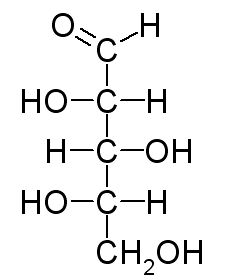
How can I convert L-xylose bond line view to Fischer projection?
Answer
516.9k+ views
Hint: We know that using wedge and dash notation, solid lines (sticks) represent chemical bonds in the plane of the surface. Black wedges represent chemical bonds coming toward you, while dashed lines are for bonds that extend back behind the surface.
Complete step by step solution:
A Fischer projection represents every chiral center as a cross. The horizontal line represents bonds extending out of the plane of the paper. The vertical line represents bonds extending behind the plane of the paper. The Fischer projection of L-xylose is

Here's how to convert the wedge-dash structure of L-xylose to its Fischer projection.
Arrange the molecule so that the chiral carbons and the longest continuous chain are in a vertical line. $ C-1 $ (the aldehyde group) goes at the top.
Draw horizontal lines to make crosses at $ C-2,\text{ }C-3, $ and $ C-4. $
Put the $ C-4\text{ }OH $ group on the correct side of the cross. We must view the molecule from the correct angle. This is an L-sugar, so the $ OH $ must be on the left, and $ C-4 $ must be closest to our eye. We must view the molecule from the lower left. We put the $ OH $ on the left arm of the cross. The $ H $ atom goes on the right.
Put the $ C-3\text{ }OH $ group on the correct side of the cross. The $ OH $ is on the left, but $ C-3 $ is furthest from our eye. We must rotate $ C-3 $ to bring it near our eye. The $ OH $ then rotates to the right. We put the $ OH $ on the right arm of the cross. The $ H $ atom goes on the left.
Put the $ C-2\text{ }OH $ group on the correct side of the cross. The $ OH $ group is on the left, and $ C-2 $ is closest to our eye. We put the $ OH $ on the left arm of the cross. The $ H $ atom goes on the right. We now have the Fischer projection of L-xylose.
Note:
Remember that the wedges are now on the right, and the dashes are on the left. It is as if we had wrapped the chain around a cylindrical tube. When you flatten the structure onto the surface of the cylinder, you get the Fischer projection of D-glucose. Understanding the concept of wedge and dash helps to understand stereochemistry and spectroscopy which is an important aspect in research.
Complete step by step solution:
A Fischer projection represents every chiral center as a cross. The horizontal line represents bonds extending out of the plane of the paper. The vertical line represents bonds extending behind the plane of the paper. The Fischer projection of L-xylose is

Here's how to convert the wedge-dash structure of L-xylose to its Fischer projection.
Arrange the molecule so that the chiral carbons and the longest continuous chain are in a vertical line. $ C-1 $ (the aldehyde group) goes at the top.
Draw horizontal lines to make crosses at $ C-2,\text{ }C-3, $ and $ C-4. $
Put the $ C-4\text{ }OH $ group on the correct side of the cross. We must view the molecule from the correct angle. This is an L-sugar, so the $ OH $ must be on the left, and $ C-4 $ must be closest to our eye. We must view the molecule from the lower left. We put the $ OH $ on the left arm of the cross. The $ H $ atom goes on the right.
Put the $ C-3\text{ }OH $ group on the correct side of the cross. The $ OH $ is on the left, but $ C-3 $ is furthest from our eye. We must rotate $ C-3 $ to bring it near our eye. The $ OH $ then rotates to the right. We put the $ OH $ on the right arm of the cross. The $ H $ atom goes on the left.
Put the $ C-2\text{ }OH $ group on the correct side of the cross. The $ OH $ group is on the left, and $ C-2 $ is closest to our eye. We put the $ OH $ on the left arm of the cross. The $ H $ atom goes on the right. We now have the Fischer projection of L-xylose.
Note:
Remember that the wedges are now on the right, and the dashes are on the left. It is as if we had wrapped the chain around a cylindrical tube. When you flatten the structure onto the surface of the cylinder, you get the Fischer projection of D-glucose. Understanding the concept of wedge and dash helps to understand stereochemistry and spectroscopy which is an important aspect in research.
Recently Updated Pages
Why are manures considered better than fertilizers class 11 biology CBSE

Find the coordinates of the midpoint of the line segment class 11 maths CBSE

Distinguish between static friction limiting friction class 11 physics CBSE

The Chairman of the constituent Assembly was A Jawaharlal class 11 social science CBSE

The first National Commission on Labour NCL submitted class 11 social science CBSE

Number of all subshell of n + l 7 is A 4 B 5 C 6 D class 11 chemistry CBSE

Trending doubts
Differentiate between an exothermic and an endothermic class 11 chemistry CBSE

10 examples of friction in our daily life

One Metric ton is equal to kg A 10000 B 1000 C 100 class 11 physics CBSE

Difference Between Prokaryotic Cells and Eukaryotic Cells

1 Quintal is equal to a 110 kg b 10 kg c 100kg d 1000 class 11 physics CBSE

State the laws of reflection of light




